You Can’t Go Home Again: The Annotated Sword of Shannara: 35th Anniversary Edition by Terry Brooks
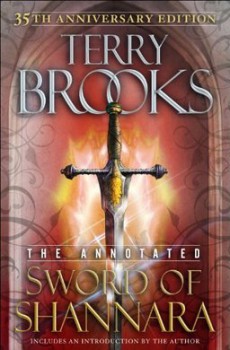 Once upon a time, said the storyteller, a band of brave travelers set off into the wilderness in desperate hope of destroying a mighty dark lord. The only thing that could destroy the villain was a single magic talisman wielded by one specific young man. Along the way they were beset by enemies known and unknown and eventually became separated. Some continued on the original quest while others decided to warn their allies in a mighty walled city of impending attack.
Once upon a time, said the storyteller, a band of brave travelers set off into the wilderness in desperate hope of destroying a mighty dark lord. The only thing that could destroy the villain was a single magic talisman wielded by one specific young man. Along the way they were beset by enemies known and unknown and eventually became separated. Some continued on the original quest while others decided to warn their allies in a mighty walled city of impending attack.
In the end, the young hero, after confronting his own inner demons, defeated the villain. At the same time, the walled city staved off defeat long enough that it could be saved by the propitious arrival of an ally’s army. The world was set right.
“Stop! Stop!” cried some in the audience. “We already know this one!”
“Shut up!” yelled others. “We liked it before and we like it this time too!”
The storyteller said, “I know you’ve heard it before, but I’m telling it my own way and I think you’ll like it.” Much of the audience cheered.
In the back of the room, a man and a woman smiled and smelled success.
In 1977 when I was eleven, I, along with hundreds of thousands of others, was part of the group that yelled “Shut up!” For us it didn’t matter that chunks of Terry Brooks’ The Sword of Shannara read like he’d simply xeroxed The Lord of the Rings, sped it up, and stripped out the hard parts, songs, and poetry. So what if the Skullbearers bore an uncanny resemblance to the Ring Wraiths and the city of Tyrsis to the city of Minas Tirith? Did it matter that gnomes were suspiciously like orcs? That the whole point of the book was to get a single young man into the dark lord’s kingdom and bring him down with a certain magic item? Heck no! We loved the first iteration of those things and wanted them all over again. We were happy to read even a slavish imitation of LotR. I read the book in about three days. At over seven hundred pages it was the longest book I had read to date. One friend stayed in his room and read it in a day.
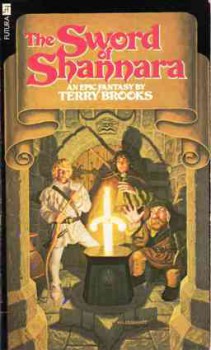 For all the Michael Moorcock, Ursula K. LeGuin, Robert E. Howard, and Roger Zelazny to enjoy in the 1970s, there was nothing quite like J.R.R. Tolkien’s The Lord of the Rings. Its epic scale — not only of quest, but of history, culture, and folklore — complex and noble heroes, and terrible, insidious villains guaranteed it a special place on every fantasy fan’s shelf and there was nothing else like it. We may have loved Elric of Melnibone and Conan the Cimmerian, but what we really wanted was more Frodo, Aragorn, and Gandalf.
For all the Michael Moorcock, Ursula K. LeGuin, Robert E. Howard, and Roger Zelazny to enjoy in the 1970s, there was nothing quite like J.R.R. Tolkien’s The Lord of the Rings. Its epic scale — not only of quest, but of history, culture, and folklore — complex and noble heroes, and terrible, insidious villains guaranteed it a special place on every fantasy fan’s shelf and there was nothing else like it. We may have loved Elric of Melnibone and Conan the Cimmerian, but what we really wanted was more Frodo, Aragorn, and Gandalf.
There had been books written clearly under the influence of Tolkien. Joy Chant’s Red Moon and Black Mountain and Lloyd Alexander’s Chronicles of Prydain each had a dark lord and an unlikely hero, but neither had the same heft. So Lester and Judy del Rey, editors at Ballantine, decided to do something about it. They wanted to prove that fantasy was a genre with potential; something that could hit the best-seller lists and move a lot of copies. Their motives, by all accounts, were more monetary than artistic.
They hunted through the slush piles at Ballantine and found what they were looking for in a submission from a man named Terry Brooks. They worked with him assiduously to craft the book of their dreams. They even hired the Brothers Hildebrandt to do the artwork (all posted at my site) and told them to make it look like their Tolkien illustrations (which I’m also discussing at my site these days). And it worked. According to Wikipedia, it sold 125,000 copies in its first month. There was even a newspaper comic strip.
In anticipation of the upcoming TV show, The Chronicles of Shannara, and to scratch an epic fantasy itch I’ve had for a while, I recently read The Annotated Sword of Shannara: 35th Anniversary Edition. The annotations by Terry Brooks provide mostly lackluster comments on the story, but some interesting ones on the process by which he, in collaboration with the del Reys, forged a book designed to be a bestseller. It was interesting to revisit a book that I once loved, to notice and study its numerous flaws while finding a few good bits as well.
For those who haven’t read The Sword of Shannara, its plot really does hew fairly close to that of LotR. Bascially, a Druid named Allanon (a name which made my wife laugh out loud when I mentioned it) tells a young man he is the only being who can wield the Sword of Shannara, the only weapon that can destroy the evil Warlock Lord. Before you can say “Tom Bombadil” there’s a band of eight men (there’s only one woman in the book and she’s named Shirl) trying to recover the sword so they can take it directly, if secretly, to the Warlock Lord’s realm — the suitably named Skull Kingdom — and destroy him with it.
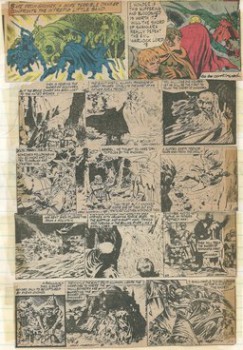 Before the end of The Sword of Shannara, there’s a multi-tentacled monster to contend with, a forest refuge to recover in, and a journey under mountains through a haunted crypt. Allanon will seemingly die in a battle with one of the Warlock Lord’s minions; the party will be split; a sniveling gnome will become obsessed with the magical sword and do anything to possess it; the fortress city of Tyrsis will come under siege only to be saved at the last minute by an ally’s fortunate arrival. The dark lord, of course, is vanquished.
Before the end of The Sword of Shannara, there’s a multi-tentacled monster to contend with, a forest refuge to recover in, and a journey under mountains through a haunted crypt. Allanon will seemingly die in a battle with one of the Warlock Lord’s minions; the party will be split; a sniveling gnome will become obsessed with the magical sword and do anything to possess it; the fortress city of Tyrsis will come under siege only to be saved at the last minute by an ally’s fortunate arrival. The dark lord, of course, is vanquished.
Word for word, the novel’s prose is acceptable. But Brooks, in opting for streamlined readability, wrote a book that merely talks when it should at least be trying to sing. The focus is all on plot and action, no myth-building or slow brewing of atmosphere. “The Four Lands” feels generic, never acquiring a sense of deep myth or history such as Tolkien created for Middle Earth.
While Brooks tried to give his story an epic feel by including numerous characters and providing each with his own adventures, he doesn’t spend enough time with any of them to really make them come to life. Only our hero Shea and his friend Menion show real flickers of personality. But for the rest he fell back on simple descriptions repeated constantly. Balinor is called the “giant borderman” over a dozen times, and both Allanon and the Wormtongue stand-in, Stenmin, are “mystics.” Even the rogue, Panamon Creel, is never given the chance to be as roguish or as dashing as Brooks insists he is.
There are some things about the book I have always liked and I was happy to find I still liked them. First, — and the book is now nearly forty years old so I’m not giving anything away — is the post-apocalyptic setting. The human-dominated world was destroyed by the Great War and the dwarfs are men who hid underground for centuries and the trolls are nuclear mutants. A monster that attacks them is a cyborg. I was a sucker for that at eleven and it still works for me.
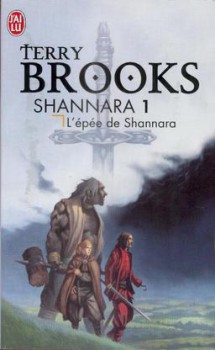 Without giving details away, Brooks’ depiction of the Warlock Lord is superbly done. The dark lord’s nature, the power of the Sword of Shannara over him, and his actual demise, are the best parts of the book. Sauron is never more than a black force seeping across Middle-earth. While Brooks spends only a few pages scattered across the book on the Warlock Lord, he is given very clear motives for his actions and failures that make sense.
Without giving details away, Brooks’ depiction of the Warlock Lord is superbly done. The dark lord’s nature, the power of the Sword of Shannara over him, and his actual demise, are the best parts of the book. Sauron is never more than a black force seeping across Middle-earth. While Brooks spends only a few pages scattered across the book on the Warlock Lord, he is given very clear motives for his actions and failures that make sense.
When I closed The Sword of Shannara this last time, I decided I don’t dislike it as much as many people do. While the del Reys were about trying to recreate the commercial success of LotR by recreating its story, Brooks clearly wanted to tell a rollicking adventure with common men driven to heroics. Although it’s shamelessly imitative, there’s a genuine enthusiasm for the story he wanted to tell, which is commendable.
It has also served as a gateway book for new readers and that’s phenomenal. Brooks writes that his original story was far darker and most of the characters were killed off, but Lester del Rey told him “in no uncertain terms” that he couldn’t do that. At that moment, Brooks continues, he decided the book should be one that “could be read by all ages,” and changed the tone and intensity.
Which is, perhaps, the secret of The Sword of Shannara’s success: it’s really a young adult book. It’s LotR with training wheels. I know many people who struggled to get through LotR when they were young, but devoured Brooks’ novel. That Sword’s plot is so beholden to LotR didn’t matter to me and my friends when we first read it. We loved that it was just like our favorite book. Only as I got older did its mimicry bother me.
Sadly, it doesn’t satisfy me anymore. There’s a depth to The Lord of the Rings that’s absent from The Sword of Shannara. Tolkien was hoping to create a set of myths. His influences were sagas and songs of the early Germanic peoples. LotR is a work derived from a deep love for history, language, and story, with which its author addressed issues of change, friendship, good, and evil. Sword deals with some of these subjects, but insubstantially. Its primary purpose is to tell an adventure story. That’s not a bad thing, but it needs to be more original if it’s to hold up over any length of time. I have stacks of fantasy books that tell fun stories without cribbing from better ones.
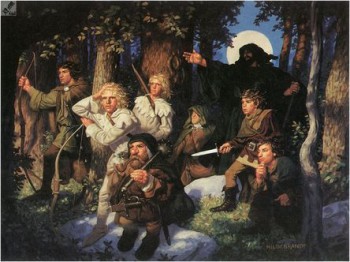 The worst sin that can be laid at The Sword of Shannara’s feet is not Terry Brooks’ fault. It’s not even the del Reys’ fault as they had no idea how successful it would be, nor how powerful the desire for more of the same. The wild success of Sword led directly to the wealth of epic-quest-against-dark-lord series that dominated fantasy fiction for the following twenty years. The publishers followed the money, and for years the public ate it up — think David Eddings, Robert Jordan, and Raymond Feist. (It wasn’t all bad. Guy Gavriel Kay’s Fionavar Tapestry and Tad Willam’s Memory, Sorrow, and Thorn were written in conversation with Tolkien’s work but stand on their own.) Unfortunately, the Tolkien-inspired works — weighing down the shelves with their thousands of pages, detailed maps, glossaries, secret heirs, and mentoring wizards — were stifling for the genre as a whole.
The worst sin that can be laid at The Sword of Shannara’s feet is not Terry Brooks’ fault. It’s not even the del Reys’ fault as they had no idea how successful it would be, nor how powerful the desire for more of the same. The wild success of Sword led directly to the wealth of epic-quest-against-dark-lord series that dominated fantasy fiction for the following twenty years. The publishers followed the money, and for years the public ate it up — think David Eddings, Robert Jordan, and Raymond Feist. (It wasn’t all bad. Guy Gavriel Kay’s Fionavar Tapestry and Tad Willam’s Memory, Sorrow, and Thorn were written in conversation with Tolkien’s work but stand on their own.) Unfortunately, the Tolkien-inspired works — weighing down the shelves with their thousands of pages, detailed maps, glossaries, secret heirs, and mentoring wizards — were stifling for the genre as a whole.
Brooks’ Sword casts a long shadow: though there are few Tolkien clones these days, George R. R. Martin has said he partly wrote The Song of Ice and Fire in response to what he called the “degraded goods” of contemporary Tolkienesque epics. So the Martin clones, writing big sprawling, multi-character epics set across vast landscapes, though not Tolkien in tone, are still direct descendents of his bastard child. Pretty impressive for a book that’s mostly derided these days.
I don’t hate The Sword of Shannara, but I doubt I will read it again. It does suffer in comparison to The Lord of the Rings. As I’ve aged my readings of Tolkien have become deeper and his themes more resonant while Brooks’ first book seems shallower and less successful than it did when I was eleven. The golden cloak of nostalgia — for my youth, for the excitement of reading a big book so quickly, for all sorts of things I associate with Sword — is fading. I fear if I read it again it will vanish entirely, and I think that might be a very sad thing.
Interesting post, Fletcher (glad you’re feeling better).
It’s been at least twenty years since I read ‘Sword,’ though I have tried somewhat to keep up with the series (I’m through The High Druid of Shannara).
But it remains one of my favorite fantasy novels. And as I mentioned in my recent post on Tolkien’s ‘Necklace of the Dwarves,’ I find Tolkien’s writing style to be extremely difficult and I’ve abandoned attempts to re-read ‘The Hobbit and the LoTR in recent years.
But I find Brook’s writing style to be no hindrance to continuing on with the saga (which is good, but not great).
The list of re-reads for a BG post includes Brooks’ Landover series, which I like somewhat, but is better in concept than execution.
Mr. Vredenburgh,
I, too, feel the nostalgia for The Sword of Shannara, which was one of the 4 books I took in my initial offering from the Science Fiction Book Club, even though I had already read it from a library copy. I think that I knew it was a significant event in fantasy publishing, despite its clear antecedents. So, I do not dislike it, either, and I also found the post-apocalyptic references intriguing. The single most compelling feature of the upcoming television adaptation was seeing the derelict, fallen Space Needle as part of the Four Lands landscape.
But it is a different experience than reading LotR, more of a quick shower compared to a long soak in the tub, each bringing about a similar outcome and each having a place in one’s busy reading life.
Mr. Byrne,
I stuck with the Shannara series for a bit, but I could only get as far as Wishsong before I felt I was simply re-reading the same tale. So, I salute you for your perseverance!
Fletcher,
I read the Sword of Shannara when I was in high school, along with a bunch of its sequels. (This was the early nineties.) I read it for precisely the reason you describe: I’d recently encountered Tolkien, and I wanted more. I genuinely enjoyed Shannara, though I knew it to be forged of baser metal. The post-apocalyptic setting also really struck me; the upcoming TV series has some really cool visuals.
But the sequels (so far as I can remember) were somewhat repetitive, and I soon grew tired of the series. That and a couple of similar experiences is what ultimately sent me hunting for pre-Tolkien works — not because I didn’t like Tolkien, but because I wanted something that was really fantastic, not a Tolkien knock-off. It was very hard to find such things then.
Thank you Fletcher for the nice review.
I am currently re-reading The Sword of Shannara (first time in English), so your contribution comes timely.
I started with LOTR, then passed to SoS, and once finished I will move “Lord Foul’s Bane”, to get a better feel of how Tolkien’s influence worked on the two authors. I haven’t lived the ’77 but I feel that the Del Rey contribution in shaping Fantasy as a commercial genre is somewhat overlooked.
Probably, compared to Prydain or other similar books, Shannara was the first Tolkien-inspired novel written for an “adult” target.
P.S. The fact that many people consider Fionavar and Memory Sorrow and Thorn as good examples of High Fantasy always amuses me.
Fionavar started unconvicingly for me (but it was an OK read) and ended with a terrible book crammed with absurd situations (like the enormous dragon disappearing into nothingness like an inflated balloon just to name one). I found the Darkest Road one of the worst books I’ve ever read together with Moonheart, which I coudn’t even finish.
GG Kay wanted to rescue the genre from the barbarians, but ended being a worse worldbuilder than them. I enjoy much more McKiernan’s Iron Tower.
Memory… was a mixed bag probably beacuse many of the cultures described (e.g. the pseudo-Normans) seem just borrowed form Hystory but they lack depth and seem more like pastiches.
Sorry maybe I ended up a off topic but that line inspired me!
After reading LOTR in the mid 1960s, I was eager for anything else which gave me the vast sweep of story along with mythic races, magical or power-imbued items and plenty of adventure, so when Shannara came along it was an automatic buy. No, it wasn’t Tolkein, but nothing is, then or since. I knew it wasn’t as “good”, but it was okay, it was fun, and it filled a vacuum. Later, I read the second book, was less entranced and didn’t continue.
What I did read was Dennis L. McKiernan’s Iron Tower trilogy, and after that the rest of his books. I like them the best by far of the books that followed the Tolkein line, and think they are quite underrated today.
I remember Sword had a huge marketing push — I think that was the first time I saw one of those cardboard stands that held like eight pockets of nothing but Shannara? I also remember an interminable wait at the library to get a copy.
I don’t actually remember much about the book itself, although I did read it, and the rest of the initial trilogy, more than once.
I don’t have any pressing desire to revisit the books, but I’m glad they’re still finding an audience and I’m definitely going to be curious about the TV series.
“…it’s really a young adult book. It’s LotR with training wheels.”
NAILED IT!
Nice job, Fletch.
I picked up “The Sword of Shannara” as soon as it came out; having read Tolkien’s books, I, too, was looking for something similar, but different enough to warrant the massive length. I gave up after a couple of chapters, and I see no reason to go back for a second try. I did give the McKiernan trilogy a chance, especially after picking them up at a library sale for less than a quarter apiece. Derivative? Absolutely. But there were enough differences, and there’d been enough time since I’d last visited Middle Earth, that McKiernan’s books kept my interest. If I want more swords and sorcery in future, however, I’m going to Fritz Leiber and Robert Howard and some authors who aren’t interested in dragging something out into a multi-book series. And, one more time before I’m too old to see, I’ll leave the Shire and travel with elves and dwarves and see Frodo off out of Rivendell.
The one thing that Shannara really did (well, with the help of D&D and Dragonlance) was to crystallize the idea of epic fantasy as “Elf/Dwarf/Orc/Dark Lord”. Which I actually find somewhat regrettable.
Joe: Yep. Exactly. That’s where the “Tolkien clones” come in…it has the effect of narrowing the vision of fantasy writers and readers. One has to make a conscious decision to play against it or to embrace it. GRRM plays against it–as do most modern fantasies (to the point where they’re being labelled as “grimdark”). But even the anti-Tolkiens are reactions to Tolkien’s work. It’s monolithic and damn-near inescapable when it comes to Epic Fantasy.
And then there’s Urshurak, which was actually coauthored by the Brothers Hildebrandt…
@Bob – thanks. I’m curious about the Landover books, having heard fairly good things about them over the years.
@Eugene – I read the next five or six, more as an experiment than any burning desire. I might read some of the later books that bridge his two series just to see how it does it.
@Raphael – At eleven gold and fool’s gold were of equal worth. From what I’ve read, some of the later books do some interesting things with the apocalyptic elements but I’m not sure I can wade thru the intervening books. As to Usharak, I was curious about it but I’ve been warned it’s abominable
@MorgonMax – I can easily understand dislike for Fionavar and Memory. The first is definitely overstuffed with archetypes and mythic characters while the latter is a little self important and ponderous. Still, I enjoyed them and think they represent laudable attempts to converse with JRRT.
@RKRobinson – For all the terrible things written about McKiernan’s books, It might be only a rubbernecker thing, but I’m curious about them nonetheless.
@JoeH – I was only a kid, but, yeah, I can remember the intensity of the push. Pretty wild and totally changed the nature of the fantasy genre. Fewer DAW-length books and more doorstoppers. I’ve long thought RPGs and the D&D novels, coupled with works like Sword did more damage to fantasy by doing exactly what you described: elf/dwarf/orc/dark lord. Personally, any non-Tolkien book with orcs ticks me off.
@JohnRFultz – Thanks, John! I was really happy to find that GRRM quote.
@smitty59 – How old were you when you picked it up? Reading this time I was really impressed at how specifically written for the YA audience it really is.
Yeah, I was pretty young at the time myself.
I do admit that I still enjoy more than my share of books with orcs in them, at least on a case-by-case basis.
The first Shannara book I ever read was the second one, The Elf Stones of Shannara. I was spending some of the summer at my dad’s house and killed time reading some of the books he had accumulated years before. Most of them were westerns, but a lot of them were Conan and S&S. I had never read anything like Elf Stones before and really liked it. I remember telling my dad that I wished there was someplace I could find more books like it. He said: “You can probably find them at the book store in the mall.” I looked at him like he was crazy. “There are book stores?”
Who knew? 😀
@Fletcher: I was in my late 20s. I’ll be 65 in exactly three weeks, which means I hope I’ve got a good 20 years left. I’d kinda like to make sure the stuff I read from here on in is REALLY worth my time — and I’m afraid that doesn’t include Terry Brooks. Had he been around 10-12 years earlier, it’d probably be a different story.
@CMR At the mall! I remember those days. I was just wandering through the mall with my wife and daughter yesterday and as they stopped at every interminable place to look at shoes or blouses I found myself wishing there was still a bookstore in the mall where I could retreat. For a while in my home town our mall had TWO bookstores. Why oh why did that change? Can it change back?
@Fletcher “We may have loved Elric of Melnibone and Conan the Cimmerian, but what we really wanted was more Frodo, Aragorn, and Gandalf.” Maybe because I read Leiber and Zelazny before LoTR I just never fell in love with it the way everyone else did. I re-read it once, but have returned again and again to Leiber, Zelazny and, later, REH and Moorcock.
I’ve always been a little curious about Shannara, and I’m glad you took such an in-depth look. I remain curious about McKiernan, having heard some good things from numerous folks and having met him and found him a very nice gentleman. I even bought several of his books and had him sign them. Perhaps it’s time to sit down and read them.
When I was growing up in the 1970s/1980s, in a town of about 25,000 people there were at least _three_ bookstores — the independent one downtown where I bought all of my comics (and eventually got a summer job during college), the Waldenbook out in the mall, and the used bookstore that had at least a few used Ballantine Adult Fantasy volumes.
These days, I think there are zero bookstores. And the mall looks like something out of a George Romero movie, but that’s another issue entirely.
We used to have two in the mall, a used book store, and a couple of others scattered around the town. And comics could be found in every supermarket and drug store.
Now you can only find comics or books if you go to specialty stores.
Yet another reason to come live in Columbus, OH. We’ve got five Barnes and Nobles’ – two of which are two-story jobs.
Borders, Pickwick, Waldenbooks, Little Professor: the other chains have gone. But we still have a few brick and mortar (plus several Half Price Books, where I usually go).
And we host PulpFest these days. And Origins. And the International Exhibition of Sherlock Holmes was here.
You know what, this actually is a cool place.
These days I’m plenty content in Minneapolis — I live within walking distance (well, a 40-50 minute walk) of Uncle Hugo’s Science Fiction Bookstore. And I went to my first-ever convention this past weekend, NerdCon: Stories, and had an amazing time.
To bring things back to Sword, I’ve been checking dates and I’m starting to question my whole timeline … Apparently Sword was published in January of 1977. I don’t _think_ I read Sword before reading Tolkien, but I didn’t start reading Tolkien until after the Rankin-Bass Hobbit cartoon came on the air, which was apparently in November of 1977. All very perplexing — I clearly should’ve kept better notes …
A side note – ‘Sword’ obviously has a cover by the Brothers Hildebrandt. As well as the “full cast” picture Fletcher included (inside cover, I think).
When the sequel, ‘Elfstones’ came out, it had a cover by Darrell K. Sweet. He also did ‘Wishsong’ and I think they were both pretty good.
I like a fair amount of the Hildebrandts’ Tolkien stuff, but I’m not an expert on them. It seems like their popularity waned around this time (perhaps by their own choice) and Sweet really emerged, with Donaldson’s Covenant books, some Tolkien and Jordan’s Wheel of Time being among his assignments.
@Howard – There was always a REH/JRRT split among my friends, but there were more of the latter. Almost everyone read both but each side had its clear favorite
@et al. – Growing up on Staten Island in the seventies there were at best two chain bookstores and three independents. There were 1-3 used stores at any given moment – that’s for a city of over 350,000 people.
Today we have a Barnes and Noble and no used bookstores. As I buy pretty much only e-books these days (lack of space and convenience win out over nostalgia and any sort of tactile pleasure) it doesn’t bother me much.
[…] for another Tolkien. The first was the Lord of the Rings-derived The Sword of Shannara (reviewed here), which makes total sense. But this? It’s a work full of crushing despair along with […]